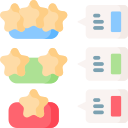AI and Machine Learning Courses Reviewed: Your Field Guide
Selected theme: AI and Machine Learning Courses Reviewed. Welcome to a clear, human-first map of the AI learning landscape—curated insights, candid stories, and practical frameworks to help you choose courses that match your goals. Join our community, subscribe for weekly deep dives, and tell us which course you want unpacked next.

Curriculum Depth and Real-World Alignment
We analyze whether topics progress from fundamentals to deployment, covering data prep, model training, validation, and responsible AI. We also check if projects mirror real-world problems instead of toy examples that fail to transfer into the workplace.

Instructor Track Record and Teaching Craft
Beyond famous names, we look for educators who demonstrate pedagogy, iterative feedback, and transparent limitations. A strong course shows working code, edge cases, and reasoning trade-offs—not just polished notebooks that hide the messy steps behind mastery.

Community, Feedback, and Ongoing Support
We score courses on discussion quality, mentor presence, office hours, and code reviews. Consistent peer dialogue accelerates learning. Tell us in the comments what type of support you value most so we can weight it more meaningfully.


Choosing the Right Path: Beginner to Advanced
Learners new to AI thrive when courses start with linear algebra intuition, probability basics, and Python workflows. We favor programs that weave math with code so concepts like gradients and overfitting become tangible rather than abstract theory.
Choosing the Right Path: Beginner to Advanced
At the intermediate stage, great curricula expand from algorithms to end-to-end pipelines: feature engineering, evaluation metrics, cross-validation, and error analysis. We appreciate courses that include scikit-learn baselines before rushing into complex deep learning.

The best projects connect metrics to outcomes: churn reduction, anomaly detection, or demand forecasting. We favor courses that ask you to define a success metric, justify choices, and document trade-offs in a concise readme and report.

We value projects that enforce environments, seeded randomness, and clear setup steps. Thoughtful READMEs, structured notebooks, and experiment logs show professionalism. Share your repo and we’ll spotlight great examples in our next feature.

Courses that teach storytelling—problem framing, method selection, results, and limitations—prepare you for interviews. A well-structured portfolio beats raw code. Tell us if you want a template; we can publish a reader-tested outline.
Time, Pacing, and Sustainable Learning Habits
We prefer courses that show median and 90th percentile completion times. Real learners need buffers for debugging, rereads, and project polishing. Plan for variability, not perfection, and celebrate steady progress over streaks.
Certificates, Hiring Signals, and Real Outcomes
We look for alumni hiring stories, recruiter feedback, and skill-based assessments. A respected certificate often pairs with rigorous projects and clear evaluation rubrics. Tell us which markets you’re targeting to refine our signal map.

Tools, Datasets, and Environments You’ll Encounter
The journey often starts in notebooks but should extend to scripts, package structure, and basic CI. We celebrate courses that teach environment management, testing, and data versioning so you graduate beyond one-off experiments.


Maya’s Pivot from Marketing to Model Evaluation
Maya began with shaky Python and a fear of calculus. By prioritizing a course with gentle math intuition and rigorous error analysis labs, she built credible projects, impressed interviewers, and landed an analyst role focused on model validation.

Diego’s Lesson: Shipping Beats Perfection
Diego stalled on a capstone for weeks, chasing state-of-the-art results. A mentor nudged him to document baselines, ship a clean pipeline, and analyze failure modes. That discipline resonated with hiring managers more than raw leaderboard scores.

Aisha’s Community Advantage
Aisha struggled alone until she joined a study pod. Weekly check-ins turned blockers into breakthroughs. She presented her time-series project at a local meetup, and that single talk sparked three interviews within a month.
